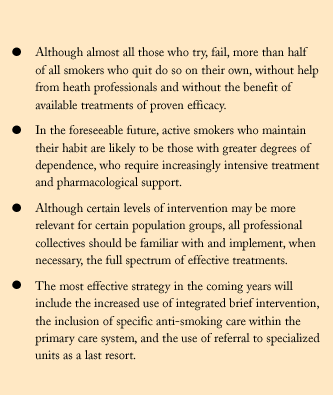Data have shown that cigarette smoking is the most widespread preventable public health problem in Spain in terms of attributable morbidity and mortality. Unfortunately, societyand perhaps many health professionalsare not yet fully aware of this fact. In general, smokers do not consider themselves to be ill (60% report enjoying good perceived health), although technically many should be considered objectively to be nicotine-dependent. These reasons justify a brief, discreet initial intervention in most smokers.
The concept of minimal intervention is unclear because this type of intervention can vary in intensity. In other words, certain types of minimal
intervention may need considerably more time than what is usually available in primary care to achieve the goals of the most widely used smoking cessation guidelines.
The WHO and the American Consensus favor the term «brief (or very brief) intervention» to designate brief counseling, and this term should be preferred to «minimal intervention». The excellent study by Torrecilla García and colleagues in this issue of Atención Primaria emphasizes the idea that both brief (minimal) intervention and pharmacological treatment offered in primary care can be as effective as specialized intervention if correct methods are used.
It is now known that ex-smokers constitute 15% of the population in Spain. This figure indicates that health professionals are encountering smokers who are increasingly unwilling to quit, ie, those who have never tried or those who have failed repeatedly. In the foreseeable future the remaining active smokers are likely to be those with greater levels of dependence, who require increasingly intensive treatment and pharmacological support with bupropion-based nicotine replacement therapy.1 However, the high prevalence of smoking in Spain suggests that there is an enormous amount of work yet to be done at all available levels of clinical intervention.
In fact, most smokers can be considered «dissonant» (ie, they do not feel comfortable with their condition as smokers). It is currently accepted that 70% of all smokers would like to quit.2 This does not mean that most smokers are willing and ready to stop, but that their intention in the middle term is to try to quit in the long run. In Spain it is estimated that at any given time, only 7% of all smokers in the general population would like to quit within the next 4 weeks, although the figure is higher than 12% for persons older than 45 years, and may be even higher in the population who seek medical attention.3 Each year 40% of all smokers try to quit, although most of them fail.2 Nevertheless, more than half of all smokers who quit do so on their own, without help from health professionals or available treatments now recognized to be highly effective.2,4 The minimum annual success rate for those who quit on their own is 1%, but if we consider attempts to quit by those who try over a period of several years, the figure rises to 7%. However, with specific, professional help the mean success rate increases to 15%-30% when modern psychological and pharmacological treatments are used.2
Data for the Spanish population indicate that at any given time there are at least 800 000 smokers willing to try to quit. Such a large volume of subjects can only be managed with the participation of the primary care service.4 The WHO has established that treatment for nicotine dependence should include pharmacological and behavioral intervention (alone or in combination) that can range from brief counseling to specialized intervention with drugs aimed at reducing nicotine dependence in smokers and in the general population. In general, the full spectrum of interventions is effective.
There is reasonable evidence that with time, persons who quit smoking consume fewer health resources, and this should encourage managers to concentrate resources on actions aimed at smoking cessation.5 Smoking is a clear paradigm of a cross-sectional health problem, and care should be organized with a view to patients´ interests and needs. Support services should be staffed by professionals trained in smoking cessation who work full-time, or during a specified number of hours per week, exclusively with smokers.2,6 Although certain levels of intervention may be more relevant for certain sectors, all professional collectives should be familiar with and implement, when necessary, the full spectrum of effective treatments. The approach to smoking cessation cannot be compartmentalized, nor should different levels of intervention be considered to represent a vertical, closed or hierarchic health care structure.
Some questions that need to be raised with regard to the future of care for smoking cessation are: What can we do to increase the use of brief interventions by primary care practitioners? Is it possible at this time to add intensive or advanced intervention to the family doctor´s usual duties? If minimal intervention is not being used, can we expect more extensive interventions to be used?
The experience of a few professionals in Spain cannot be extrapolated to the entire primary care system. There are problems arising from the lack of time (with 5 min per patient, prevention and health promotion cannot effectively be integrated into the family doctor´s every-day consulting activities); there are problems with skills (medical schools do not train physicians in smoking cessation interventions); but above all, there are problems of attitude. Too many doctors and nurses smoke, and the problem does not appear to receive the priority it deserves. Difficulties are magnified, opportunities minimized. This situation needs to be reversed with structural reform, increased training and motivation, the promotion of smoke-free health centers, and a social environment more favorable to the regulation of smoking. The road ahead is long, complicated, and difficult, but in the long run the public health benefits will make traveling this road worth the effort.







